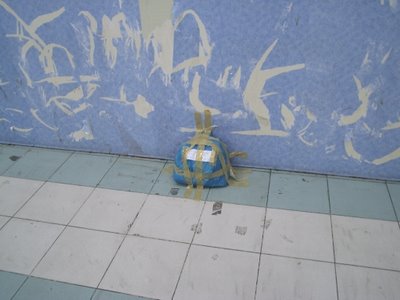After a few days in Kathmandu I decided it was time to get out and explore the valley a little. I decided upon an overnight stay in Nagarkot, a hill-station 35km east of Kathmandu, famous for its Himalayan views, especially at sunset and sunrise.
Dodging a Maoist rally just outside Thamel I took a taxi to the old bus stand, where I hopped on a crowded bus to Bhaktapur – passing three more rallies on the way – for the connecting bus to Nagarkot. The second bus was even more crowded than the first, so I decided to clamber up and sit on the roof, a first for me. Despite the discomfort of perching on the luggage rack it was an exhilarating experience, especially with the great views over the valley as we made our way uphill.
There was a little drama when we ground to a halt and everyone suddenly started jumping out of the doors or leaping off the roof. I didn’t really know what it was all about until I climbed down and noticed the increasing pool of petrol leaking from underneath the bus. Some guy was studiously inspecting the leak – fine – although worryingly he had a lit cigarette between his lips. Along with about a third of the other passengers I decided to walk the last few kilometres. The bus did overtake us later on, just before breaking down again.
Now I probably only saved about Rs150 (just over $2) travelling by public transport rather than some kind of tourist bus but frankly, where’s the fun in that?
Once I finally arrived in Nagarkot I hiked further up the ridge and found myself a charming little ‘bamboo hut’ (actually half brick, half wood) overlooking the valley. It cost Rs300, after a little haggling. Perfect.
The next morning I was up at 4.30am for the walk to an observation tower in time for sunrise. With no moon and little light pollution to speak of, the night sky was filled with stars. Equipped with a head torch, I walked the several kilometres uphill out of town to the observation tower, originally part of the Survey Department’s Trigonometrical Station.
Near the top I was passed by a couple of taxis, filled with tourists who had (perhaps sensibly) decided that a few hundred rupees was fair trade for an extra 45 minutes in bed. Still, it was worth the walk. As the sun rose, the mountain ranges came into view, along with the rolling blue foothills rising from the valley. A spectacular panorama gradually appeared: to the northwest, the Ganesh Himal; to the north, the peaks of the Langtang Himal. Apparently, on a clear day you can see five of the world’s eleven highest peaks including the Annapurna Range to the west and even distant Everest in the east, but it was a little cloudy for that. I wasn’t complaining however, and neither were any of the other 20 or so tourists scattered about.
The walk back was a breeze, although I felt sorry for the army soldiers barracked here who have to run up and down to Bhaktapur every day. Several platoons passed me by on their early morning jogs as I strolled gently down.
After loading up with a hearty breakfast, I checked out and hit the trail. My plan was to hike the 3-4 hours to Changu Narayan (a historic temple and world heritage site) before continuing down to Bhaktapur for the bus back to Kathmandu. It sounded reasonable enough in my guidebook (a vintage first edition Rough Guide) but with a fully loaded backpack, it was hard work. Still, the decent along the ridge was wonderful, passing through interesting little villages and through lovely countryside along the way. The temple itself was interesting, with intricate wood carvings decorating the exterior and several priceless statues scattered about the grounds, though some restoration work was taking place on a nearby building (looked more like a demolition to me) so there was a lot of dust flying about in the strong wind.
It’s at least 10km from Nagarkot to Changu Narayan, and a further 5km down to Bhaktapur. Combined with the trip to the observation tower it was a fair amount of walking in one day, but undoubtedly good practice for the trekking that’s to follow once Matt arrives…
In front of the Langtang Himal, viewed from Nagarkot.
I’m laughing thanks to the young Japanese tourists who took the picture, who made me say ‘SUSHI!’ as the shutter clicked. They all joined in.
Buddhist prayer flags silhouetted by the sunrise, Nagarkot.
Countryside on the walk from Nagarkot to Changu Narayan
The entire walk had views like this. The countryside here reminds me of the hills near Sapa in north Vietnam, although it was rainy season when I was there.
